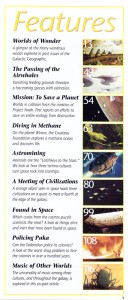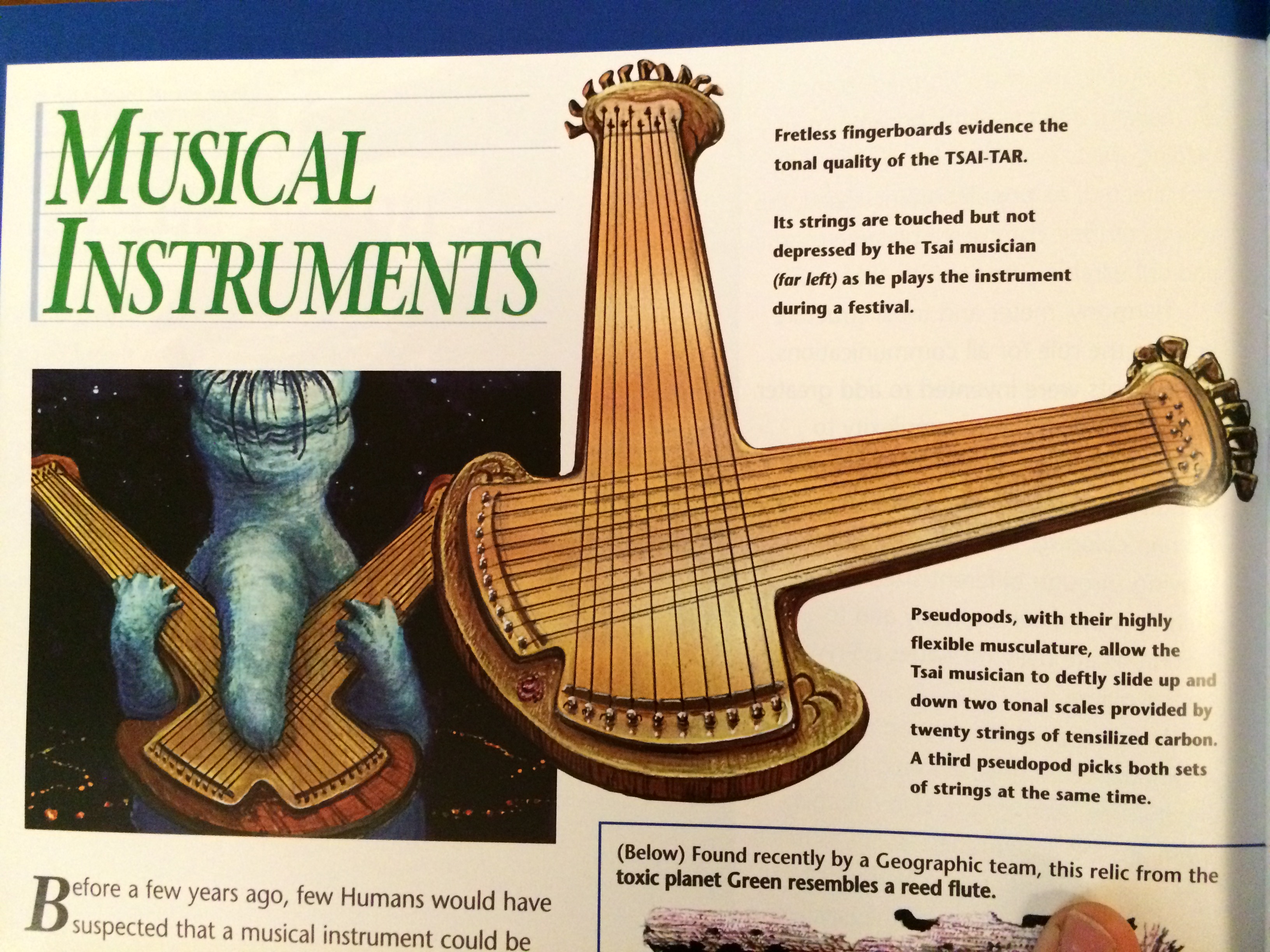One of the great sources of fun one can have in the worldbuilding process is making it so your ideas are all compatible. When the components all sing together, you can find yourself with an entire universe of ideas; one where you canlook from all different directions at the philosophical assertions that sit at the core of your exploration.
…Look from all different directions at the philosophical assertions that sit at the core of your exploration.
Other times, a creator stretches their creative muscles to make a universe that’s beautiful and weird, conceding as little as possible to recognizability.
 Originally published in 2003, Karl Kofoed’s Galactic Geographic 3003 Annual does the latter in a really beautiful way. In the tradition of Wayne Barlowe’s Expedition, Dougal Dixon’s After Man, and Alec Gillis’ Worlds, it tells the story of humans a thousand years hence as they travel the galaxy making friends when things go well, and at least recording the mysteries of the experience when they don’t. The story is told implicitly through speculative zoölogy and sophontology, assuming that you, as a curious layreader in the year 3003, know the broad outlines, but not the details of our history as members of the interstellar community.
Originally published in 2003, Karl Kofoed’s Galactic Geographic 3003 Annual does the latter in a really beautiful way. In the tradition of Wayne Barlowe’s Expedition, Dougal Dixon’s After Man, and Alec Gillis’ Worlds, it tells the story of humans a thousand years hence as they travel the galaxy making friends when things go well, and at least recording the mysteries of the experience when they don’t. The story is told implicitly through speculative zoölogy and sophontology, assuming that you, as a curious layreader in the year 3003, know the broad outlines, but not the details of our history as members of the interstellar community.
Kofoed does that by showing us paintings, photocollages, essays, and sculpture that he’s made over the course of years, then binding them together into a shared context of celebration.
In his world, humans are part of a small group of species who are a) capable of co-perceiving each other, and b) have compatible ideas about things like “friendship” or “federation” or “mystery” or even “language”. Kofoed has built a universe where humanity has been able, against the odds, to find fellow explorers with whom we mostly find complex, interfolded mysteries to investigate, befriend, sample, or occasionally be consumed by. With our fellow explorers of the Federation, hailing from the planets Noron and Tsailerol, we sniff out the possible places where we might find life, from asteroids with isolated biospheres to planet-wide systems of plant/animals that feel more like The Dark Crystal‘s world of Thra than Arrakkis. There are still teddy bear people and airwhales, staples that they are of the genre, but Kofoed outnumbers them with novel physiologies, sociologies, and psychologies at every opportunity.
This book was recommended to me by Matt Howarth (who makes a cameo therein). I’ve been a fan of Matt’s since the 1980s. His interests in bizarre aliens and equally bizarre music is echoed on these pages with several descriptions of music and instruments from different planets. I have a strong suspicion that some of this music could be found at Dr. Broccoli’s.
Kofoed has published a good number of these pieces in Heavy Metal over the years, so some of it might look familiar to you. The older pieces, as reproductions, have not aged as well as the art they depict, but the book is beautiful on the whole.
You can get ahold of a copy on Amazon, of course, but give your money to Karl instead. Email him directly and he’ll sign it for you. He has found himself with a good number of volumes at his house, and if you PayPal him $20 (That’s $15 for the book, $5 for US shipping; If you’re international, you should buy it from Amazon after all) you’ll find yourself in possession of a rare gem of SF Art.




